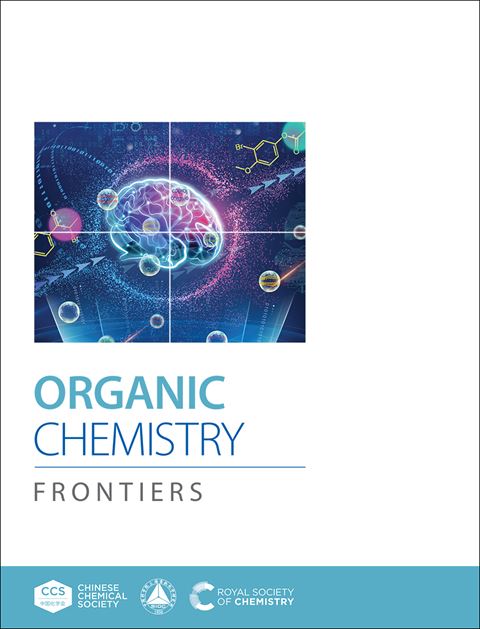钯催化烯-烯交偶联的计算研究
IF 4.7
1区 化学
Q1 CHEMISTRY, ORGANIC
引用次数: 0
摘要
[4]树突烯的构建是一个重大的合成挑战。钯催化氧化丙烯-丙烯交叉偶联具有高选择性,但其机制基础、竞争途径和速率决定步骤尚不清楚。本文利用密度泛函理论(DFT)方法研究了钯催化的氧化丙烯-丙烯交叉偶联机理。我们系统地评估了三取代烯反应物上R基团的两个竞争途径(Pathway1和Pathway2),它们带有-CH₂-EWG(吸电子基团)或-CH₂-芳基取代基。计算结果表明,在β-H消除步骤中,涉及选择性α-C-H键切割的Pathway2在动力学上是有利的(ΔΔG‡= 7.3 kcal mol⁻¹),与实验观察结果密切相关。carbopallation (ΔG‡= 22.8 kcal mol⁻¹)被确定为途径1和途径2的速率决定步骤(RDS)。机制分析合理化了该策略的显著选择性,包括(i)区域选择性C-H活化,(ii)交叉选择性碳环化-碳化,以及(iii)立体选择性顺/反异构。文献空白-具体来说,缺乏对钯催化氧化丙烯-丙烯交叉偶联选择性的机制理解,包括有关竞争途径和速率决定步骤的未解决问题-已被清楚地解释。此外,我们揭示了烯丙基导向基团的关键作用,它通过协同Pd-π相互作用促进C-H活化。扭曲-相互作用(D/I)分析表明,较高的扭曲能量是造成这种区域选择性的原因。这项工作为树突烯结构的设计提供了原子水平的见解,并拓宽了立体控制多烯合成的范围。本文章由计算机程序翻译,如有差异,请以英文原文为准。
Computational investigation of palladium-catalyzed allene–allene cross-coupling
The construction of [4]dendralenes poses a significant synthetic challenge. Palladium-catalyzed oxidative allene–allene cross-coupling offers high selectivity, but its mechanistic basis, competing pathways, and rate-determining step remain unclear. Herein, we investigate a palladium-catalyzed oxidative allene–allene cross-coupling mechanism using density functional theory (DFT) methods. Two competing pathways (Pathway1 and Pathway2) for R groups on the trisubstituted allene reactant, bearing either a -CH₂-EWG (electron-withdrawing group) or -CH₂-Aryl substituent, were systematically evaluated. Computational results show that Pathway2, involving selective allenic α-C-H bond cleavage in the β-H elimination step, is kinetically favored (ΔΔG‡ = 7.3 kcal mol⁻¹), strongly correlating with experimental observations. Carbopalladation (ΔG‡ = 22.8 kcal mol⁻¹) is identified as the rate-determining step (RDS) for both Pathway 1 and Pathway 2. Mechanistic analysis rationalizes the remarkable selectivities of this strategy, including (i) regioselective C–H activation, (ii) cross-selective carbocyclization–carbopalladation, and (iii) stereoselective cis/trans isomerism. The literature gap—specifically, the lack of mechanistic understanding of selectivity in palladium-catalyzed oxidative allene-allene cross-coupling, including unresolved questions about competing pathways and rate-determining steps—has been clearly explained. Furthermore, we reveal the pivotal role of the allylic directing group, which facilitates C–H activation through a synergistic Pd-π interaction. Distortion-interaction(D/I) analysis analysis revealed that higher distortion energy is responsible for this regioselectivity. This work provides atomic-level insights into the design of dendralene architectures and broadens the scope of stereocontrolled polyene synthesis.
求助全文
通过发布文献求助,成功后即可免费获取论文全文。
去求助
来源期刊

Organic Chemistry Frontiers
CHEMISTRY, ORGANIC-
CiteScore
7.90
自引率
11.10%
发文量
686
审稿时长
1 months
期刊介绍:
Organic Chemistry Frontiers is an esteemed journal that publishes high-quality research across the field of organic chemistry. It places a significant emphasis on studies that contribute substantially to the field by introducing new or significantly improved protocols and methodologies. The journal covers a wide array of topics which include, but are not limited to, organic synthesis, the development of synthetic methodologies, catalysis, natural products, functional organic materials, supramolecular and macromolecular chemistry, as well as physical and computational organic chemistry.
 求助内容:
求助内容: 应助结果提醒方式:
应助结果提醒方式:


